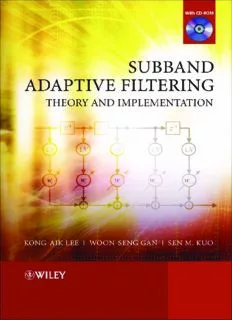
Subband Adaptive Filtering: Theory and Implementation PDF
Preview Subband Adaptive Filtering: Theory and Implementation
Subband Adaptive Filtering Subband Adaptive Filtering Theory and Implementation Kong-Aik Lee Institute for Infocomm Research, Singapore Woon-Seng Gan Nanyang Technological University, Singapore Sen M. Kuo Northern Illinois University, USA A John Wiley and Sons, Ltd., Publication Disclaimer: This eBook does not include ancillary media that was packaged with the printed version of the book. Thiseditionfirstpublished2009 2009,JohnWiley&Sons,Ltd. Registeredoffice JohnWiley&Sons,Ltd,TheAtrium,SouthernGate,Chichester,WestSussex,PO198SQ,UnitedKingdom Fordetailsofourglobaleditorialoffices,forcustomerservicesandforinformationabouthowtoapplyforpermission toreusethecopyrightmaterialinthisbookpleaseseeourwebsiteatwww.wiley.com. TherightoftheauthortobeidentifiedastheauthorofthisworkhasbeenassertedinaccordancewiththeCopyright, DesignsandPatentsAct1988. Allrightsreserved. Nopartofthispublicationmaybereproduced, storedinaretrievalsystem,ortransmitted,inany form or by any means, electronic, mechanical, photocopying, recording or otherwise, except as permitted by the UK Copyright,DesignsandPatentsAct1988,withoutthepriorpermissionofthepublisher. Wileyalsopublishesitsbooksinavarietyofelectronicformats.Somecontentthatappearsinprintmaynotbeavailable inelectronicbooks. Designations used by companies to distinguish their products are often claimed as trademarks. All brand names and productnamesusedinthisbookaretradenames,servicemarks,trademarksorregisteredtrademarksoftheirrespective owners.Thepublisherisnotassociatedwithanyproductorvendormentionedinthisbook.Thispublicationisdesigned toprovideaccurateandauthoritativeinformationinregardtothesubjectmattercovered.Itissoldontheunderstanding thatthepublisherisnotengagedinrenderingprofessional services.Ifprofessional adviceorotherexpertassistanceis required,theservicesofacompetentprofessionalshouldbesought. MATLAB MATLABandanyassociatedtrademarksusedinthisbookaretheregisteredtrademarksofTheMathWorks, Inc. ForMATLAB productinformation,pleasecontact: TheMathWorks,Inc. 3AppleHillDrive Natick,MA,01760-2098USA Tel:508-647-7000 Fax:508-647-7001 E-mail:[email protected] Web:www.mathworks.com LabVIEWTM andNationalInstrumentsTM aretrademarksandtradenamesofNationalInstrumentsCorporation. InteractiveLabVIEW-basedapplicationsareavailabletosupportselectedconceptsandexercisesfromthetextbook.The softwareisavailableonthecompanionwebsiteforthisbook:www3.ntu.edu.sg/home/ewsgan/saf_book.htmlordirectly fromtheNationalInstrumentswebsite(gotohttp://www.ni.com/infoandenterthecodesaftext). LibraryofCongressCataloging-in-PublicationData Lee,Kong-Aik. Subbandadaptivefiltering:theoryandimplementation/byKong-AikLee, Woon-SengGan,SenM.Kuo. p. cm. Includesbibliographicalreferencesandindex. ISBN978-0-470-51694-2(cloth) 1. Adaptivefilters. 2. Adaptivesignalprocessing. 3. Radiofrequency modulation,Narrow-band. I. Gan,Woon-Seng. II. Kuo,SenM.(Sen-Maw) III. Title. TK7872.F5L4352009 621.3815(cid:1)324–dc22 2009015205 AcataloguerecordforthisbookisavailablefromtheBritishLibrary. ISBN:978-0-470-51694-2 Typesetin10/12ptTimesbyLaserwordsPrivateLimited,Chennai,India. PrintedandboundinGreatBritainbyCPIAntonyRowe,Chippenham,Wiltshire Contents About the authors xi Preface xiii Acknowledgments xv List of symbols xvii List of abbreviations xix 1 Introduction to adaptive filters 1 1.1 Adaptive filtering 1 1.2 Adaptive transversal filters 2 1.3 Performance surfaces 4 1.4 Adaptive algorithms 6 1.5 Spectral dynamic range and misadjustment 13 1.6 Applications of adaptive filters 15 1.6.1 Adaptive system identification 15 1.6.2 Adaptive prediction 23 1.6.3 Adaptive inverse modeling 25 1.6.4 Adaptive array processing 28 1.6.5 Summary of adaptive filtering applications 31 1.7 Transform-domain and subband adaptive filters 31 1.7.1 Transform-domain adaptive filters 31 1.7.2 Subband adaptive filters 38 1.8 Summary 39 References 39 2 Subband decomposition and multirate systems 41 2.1 Multirate systems 41 2.2 Filter banks 44 2.2.1 Input–output relation 46 vi CONTENTS 2.2.2 Perfect reconstruction filter banks 47 2.2.3 Polyphase representation 48 2.3 Paraunitary filter banks 54 2.4 Block transforms 55 2.4.1 Filter bank as a block transform 55 2.5 Cosine-modulated filter banks 59 2.5.1 Design example 63 2.6 DFT filter banks 65 2.6.1 Design example 66 2.7 A note on cosine modulation 67 2.8 Summary 68 References 69 3 Second-order characterization of multirate filter banks 73 3.1 Correlation-domain formulation 73 3.1.1 Critical decimation 77 3.2 Cross spectrum 79 3.2.1 Subband spectrum 82 3.3 Orthogonality at zero lag 85 3.3.1 Paraunitary condition 86 3.4 Case study: Subband orthogonality of cosine-modulated filter banks 89 3.4.1 Correlation-domain analysis 89 3.4.2 MATLAB simulations 92 3.5 Summary 96 References 97 4 Subband adaptive filters 99 4.1 Subband adaptive filtering 99 4.1.1 Computational reduction 100 4.1.2 Spectral dynamic range 101 4.2 Subband adaptive filter structures 104 4.2.1 Open-loop structures 104 4.2.2 Closed-loop structures 104 4.3 Aliasing, band-edge effects and solutions 106 4.3.1 Aliasing and band-edge effects 107 4.3.2 Adaptive cross filters 108 4.3.3 Multiband-structured SAF 110 4.3.4 Closed-loop delayless structures 113 4.4 Delayless subband adaptive filters 114 4.4.1 Closed-loop configuration 114 4.4.2 Open-loop configuration 115 4.4.3 Weight transformation 116 4.4.4 Computational requirements 123 4.5 MATLAB examples 124 4.5.1 Aliasing and band-edge effects 125 CONTENTS vii 4.5.2 Delayless alias-free SAFs 126 4.6 Summary 128 References 129 5 Critically sampled and oversampled subband structures 133 5.1 Variants of critically sampled subband adaptive filters 133 5.1.1 SAF with the affine projection algorithm 134 5.1.2 SAF with variable step sizes 136 5.1.3 SAF with selective coefficient update 137 5.2 Oversampled and nonuniform subband adaptive filters 138 5.2.1 Oversampled subband adaptive filtering 138 5.2.2 Nonuniform subband adaptive filtering 140 5.3 Filter bank design 141 5.3.1 Generalized DFT filter banks 141 5.3.2 Single-sideband modulation filter banks 142 5.3.3 Filter design criteria for DFT filter banks 144 5.3.4 Quadrature mirror filter banks 149 5.3.5 Pseudo-quadrature mirror filter banks 153 5.3.6 Conjugate quadrature filter banks 155 5.4 Case study: Proportionate subband adaptive filtering 156 5.4.1 Multiband structure with proportionate adaptation 156 5.4.2 MATLAB simulations 157 5.5 Summary 161 References 163 6 Multiband-structured subband adaptive filters 167 6.1 Multiband structure 167 6.1.1 Polyphase implementation 170 6.2 Multiband adaptation 173 6.2.1 Principle of minimal disturbance 173 6.2.2 Constrained subband updates 173 6.2.3 Computational complexity 175 6.3 Underdetermined least-squares solutions 177 6.3.1 NLMS equivalent 178 6.3.2 Projection interpretation 179 6.4 Stochastic interpretations 179 6.4.1 Stochastic approximation to Newton’s method 179 6.4.2 Weighted MSE criterion 181 6.4.3 Decorrelating properties 186 6.5 Filter bank design issues 187 6.5.1 The diagonal assumption 187 6.5.2 Power complementary filter bank 187 6.5.3 The number of subbands 188 6.6 Delayless MSAF 189 6.6.1 Open-loop configuration 189 viii CONTENTS 6.6.2 Closed-loop configuration 191 6.7 MATLAB examples 192 6.7.1 Convergence of the MSAF algorithm 193 6.7.2 Subband and time-domain constraints 195 6.8 Summary 198 References 199 7 Stability and performance analysis 203 7.1 Algorithm, data model and assumptions 203 7.1.1 The MSAF algorithm 203 7.1.2 Linear data model 204 7.1.3 Paraunitary filter banks 206 7.2 Multiband MSE function 209 7.2.1 MSE functions 209 7.2.2 Excess MSE 210 7.3 Mean analysis 211 7.3.1 Projection interpretation 211 7.3.2 Mean behavior 213 7.4 Mean-square analysis 214 7.4.1 Energy conservation relation 214 7.4.2 Variance relation 216 7.4.3 Stability of the MSAF algorithm 216 7.4.4 Steady-state excess MSE 217 7.5 MATLAB examples 219 7.5.1 Mean of the projection matrix 219 7.5.2 Stability bounds 220 7.5.3 Steady-state excess MSE 222 7.6 Summary 223 References 224 8 New research directions 227 8.1 Recent research on filter bank design 227 8.2 New SAF structures and algorithms 228 8.2.1 In-band aliasing cancellation 228 8.2.2 Adaptive algorithms for the SAF 230 8.2.3 Variable tap lengths for the SAF 230 8.3 Theoretical analysis 232 8.4 Applications of the SAF 232 8.5 Further research on a multiband-structured SAF 233 8.6 Concluding remarks 234 References 235 Appendix A Programming in MATLAB 241 A.1 MATLAB fundamentals 241 A.1.1 Starting MATLAB 241 A.1.2 Constructing and manipulating matrices 244 A.1.3 The colon operator 244
Description: